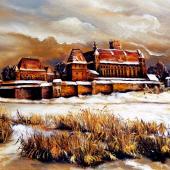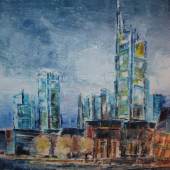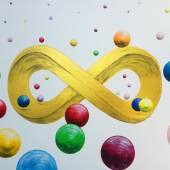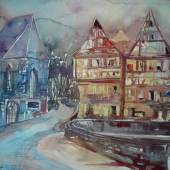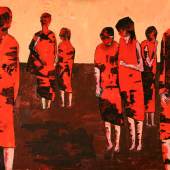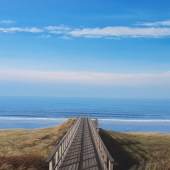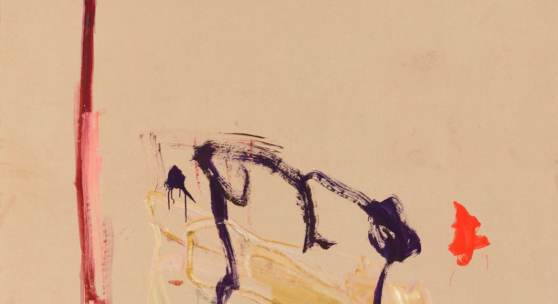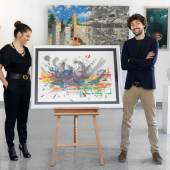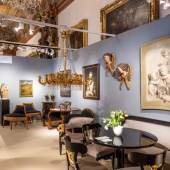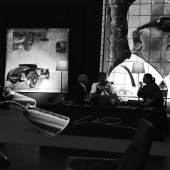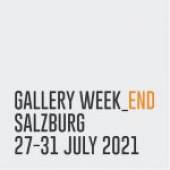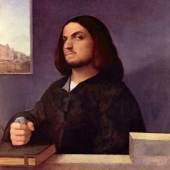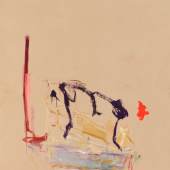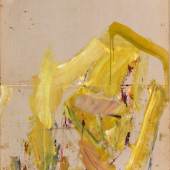Martha Jungwirth Recent Paintings
-
Ausstellung04.09.2021 - 16.10.2021
In her poetic essay ‘der affe in mir’ (‘the ape in me’) from 1988, she coined the essence of her practice: ‘My painting is tied to me, to the moment, the uncontrolled release of the flow, the unity of time and ingestion, Back to the old brains, to the senso-motoric, before spoken language, before memory, before the obtrusiveness of objects. Risk instead of concept. Non finito’.
The physical intensity of Martha Jungwirth's tactile surfacesand eruptions of colour are balanced by her delicate sensitivity and restraint. The brushstrokes, splatters, stains and 'constellations of blotches' never overwhelm her chosen surfaces, as areas of untouched cardboard or collaged paper play a crucial role in the composition and become arenas for gestural actions. All traces of the artist's movements remain visible in the finished painting, as an intimate index of her process. ‘Each of Jungwirth’s works can be construed as the relic of a performative act, providing a document of her actions, but with results somewhat reminiscent of Cy Twombly’s paintings of the 1960s.’ — Sherman Sam, Artforum, January 2018. Hans-Peter Wipplinger, Director of the Leopold Museum, stated on the occasion of the retrospective at Museum Liaunig in Neuhaus, Austria, in 2020: ‘The hidden in the memory archive plays a role in these color thunderstorms. Her works are poetic and dramatic representations of experiences, emotions and memories that convey a deep awareness of the immeasurableness of reality.’ Martha Jungwirth works embody the functions of myths as described by Hesiod - exploring the origins of the world, between order and disorder, organising the initial chaos, depicting the violent emergence of new gods and civilisations. Her work, often described as a ‘controlled chaos’ follows a process of transforming the painterly surface into streams of energy is driven by Heraklit’s famous saying ‘Panta Rhei’ (‘Everything flows’). According to this idea, Art Historian Jörg Heiser resumed Jungwirth’s work as ‘liberated capturing’, comparing her to Joan Mitchell. Referring to the essence of the mythology, Martha Jungwirth composes and shapes new painterly worlds that welcome the chaos and explore incessantly the fundamental act of creativity. About the artist Martha Jungwirth was born in 1940 in Vienna, where she continues to live and work. In 1961, while still a student at the Academy of Applied Arts (1956–63), she was awarded the Msgr. Otto Mauer Prize, followed by the Theodor Körner Prize (1964) and the Joan Miró Prize (1966). Having studied under Professor Carl Unger, she later taught at the Academy of Applied Arts in Vienna for a decade from 1967–77. In 1968 she was the only woman among the founding members of the loose group of artists ‘Wirklichkeiten’ [‘Realities’] alongside Wolfgang Herzig, Kurt Kocherscheidt, Peter Pongratz, Franz Ringel and Robert Zeppel-Sperl, whose work was shown in the exhibition at the Secession, Vienna in 1968, curated by Otto Breicha. The group exhibited together from 1968–72. In 1977, Jungwirth was included in documenta 6 in Kassel. More recently, an entire room was dedicated to her work in the exhibition curated by Albert Oehlen for the Essl Museum, Klosterneuburg in 2010. A career retrospective spanning five decades was shown at the Kunsthalle Krems in 2014, followed by an exhibition focusing on her watercolours at the Kunstmuseum Ravensburg in 2018. That same year, she received the prestigious Oskar Kokoschka Prize awarded by the Austrian state, accompanied by an extensive solo exhibition at the Albertina in Vienna. A retrospective at the Museum Liaunig in Neuhaus marked the occasion of the artist’s 80th birthday in 2020. Over the last few decades, Martha Jungwirth’s work, once described as a missing link between American abstract expressionism and European informal painting, became more abstract, expressive and colourful. Pursuing her own, distinctive path, she forged a singular approach to abstraction grounded in the body and her closely observed perceptions of the world around her. Her work is revered by different generations of artists and now exhibited and housed in the collections of significant institutions such as Albertina Museum, Vienna and Centre Pompidou, Paris.
-
27.07.2021 - 31.07.2021Mit dem GALLERY WEEK_END 2021 erhält die Kulturszene Salzburgs ein neues Veranstaltungs-format,...
-
23.03.2024 - 01.04.2024Die Messe für Kunst, Antiquitäten und Design gehört zum österlichen Salzburg wie die Palmbuschen...
-
14.10.2022 - 16.10.2022Im Messezentrum Salzburg laufen die Aufbauarbeiten für die 18. Auflage der Internationalen...
-
Zunehmend kamen auch realistische Strömungen nach Venedig. Die Künstler aus Brescia,...
-
04.09.2021 - 16.10.2021
4 September—16 October 2021
Opening Saturday 4 September, 5—8pm
with the artist presentParis Marais
7, rue Debelleyme
75003 Paris
